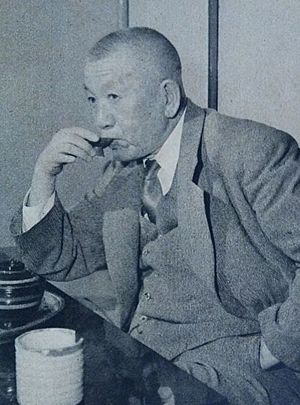Isamu Yoshii facts for kids
Quick facts for kids
Count
Isamu Yoshii
|
|
|---|---|

Yoshii in January 1955
|
|
| Native name |
吉井 勇
|
| Born | October 8, 1886 Tokyo, Japan |
| Died | November 9, 1960 (aged 74) Tokyo, Japan |
| Resting place | Aoyama Cemetery, Tokyo, Japan |
| Occupation | Writer, playwright and poet |
| Language | Japanese |
| Alma mater | Waseda University |
| Genre | tanka poetry, stage plays |
| Literary movement | Pan no Kai |
Count Isamu Yoshii (吉井 勇, Yoshii Isamu, October 8, 1886 - November 9, 1960) was a Japanese poet and playwright. He was active during the Taishō period and Shōwa period in Japan. He wrote a special type of Japanese poetry called tanka. When he was young, he liked European romanticism. His later writings were more calm and simple.
Early Life and Education
Isamu Yoshii was born in Tokyo, Japan, in a fancy area called Takanawa. His grandfather, Count Yoshii Tomosane, was a former samurai. He was also an important government official.
From 1887, Yoshii lived at his father's house in Kamakura. He started elementary school there in 1891. The next year, his family moved back to Tokyo. But he often returned to Kamakura to rest when he was not feeling well.
He began writing short poems while he was in junior high school.
In 1908, Yoshii briefly studied at Waseda University. However, he left the same year to join a poetry group. This group was called Tokyo Shin-shi Sha, led by Yosano Tekkan. Yoshii started writing his tanka poems for their magazine, Myōjō (which means Bright Star). In this group, he met and was inspired by famous writers like Mori Ōgai and Kitahara Hakushū.
Literary Career and Works
Yoshii left the Myōjō group to start a new one called Pan no Kai. He formed this group with Kitahara Hakushu. They both liked romanticism and a style called aestheticism. In 1909, with help from Mori Ōgai, Yoshii launched a new literary magazine called Subaru.
In 1910, Yoshii published his first collection of tanka poems. It was called Sakehogai, which means Revelry. This book shared the feelings of a young poet.
Yoshii was also interested in the Shingeki (New Theater) movement. His first stage play was a collection of eleven short plays. It was called Gogo Sanji (3 PM). This play was published in Subaru in 1911. This was his first time writing for the stage. After this, he wrote other plays like Yumesuke to So to and Kyo Geinin.
He traveled around different parts of Japan, including Shikoku, Kyūshū, and Kyoto. In 1925, he joined a group that created radio dramas. This was for the Tokyo Broadcasting Corporation, which later became NHK. In the same year, he wrote scripts for radio plays. Some of these were Saigo no Seppun (The Last Kiss) and Kamome no Shigai (Dead Seagull). In 1927, his play Ame no Yobanashi (Night Stories in the Rain) was broadcast on the radio. This story was about a sad traveling performer. It became very popular and made Yoshii well-known when radio was new.
Later Life and Legacy
In his later years, Yoshii lived near Mount Hiei in Kyoto. He often visited the Gion area, which is famous for its entertainment. Every year on November 8, a festival is held to remember him. During this festival, the geiko and maiko (traditional Japanese entertainers) of Gion place flowers at a monument with his Tanka poem on it.
In 1948, Yoshii was chosen to be a poetry selector for the Imperial Household's New Year poetry reading ceremony. He also became a member of the Japan Art Academy that same year. Isamu Yoshii passed away in 1960 when he was 74 years old. His grave is in the Aoyama Cemetery in Tokyo.
See also
 In Spanish: Isamu Yoshii para niños
In Spanish: Isamu Yoshii para niños
- Japanese literature
- List of Japanese authors

